Urbanization - Energy Sources
Overview
Urbanization and Basal Energy Sources
- Organic carbon produced by photosynthesis outside the stream, or allochthonous production
- Organic carbon produced by photosynthesis within the stream, or autochthonous production
Most streams rely on both allochthonous and autochthonous energy, although the relative importance of each varies with elevation, stream size and other factors. For example, terrestrial carbon is more important in forested headwater streams, whereas autochthonous carbon is more important in open-canopied, mid-sized rivers.
-
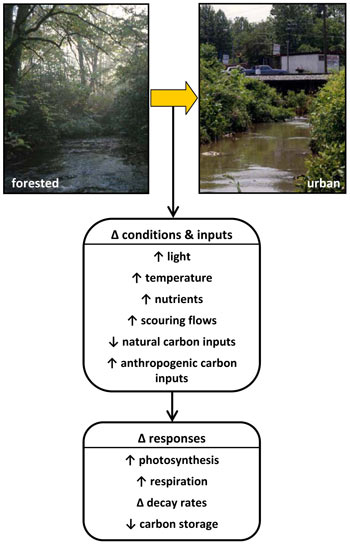
- Increased light and algal production
- Decreased terrestrial litter and wood inputs
- Increased nutrient enrichment, resulting in increased algal production and microbial respiration
- Increased input of sewage-derived particulate organic matter
- Decreased algal biomass, due to scouring flows
- Altered relative importance of physical vs. biological factors in determining leaf decay rates
Changes in resources can result in changes in the consumer community. For example, invertebrate functional feeding groups may change. Reduced leaf litter may lead to few shredder invertebrates. Increased algal production may lead to increased scrapers. Increased input of particulate organic matter may lead to increased filterers. However, these changes often are mitigated by concurrent changes in habitat and water quality.
Terrestrial Leaf Litter Inputs and Retention

- Decreased leaf litter inputs resulting from riparian alteration and stream burial
[Carroll and Jackson 2008] - Increased leaf litter inputs due to increased horizontal delivery (e.g., via stormdrains)
[Miller and Boulton 2005, Carroll and Jackson 2008] - Altered type and timing of inputs due to changes in riparian taxa
[Imberger et al. 2008, Roberts and Bilby 2009] - Decreased leaf litter retention due to scouring by high flows and reductions in debris dams
[Paul and Meyer 2001]
Terrestrial Leaf Litter Processing
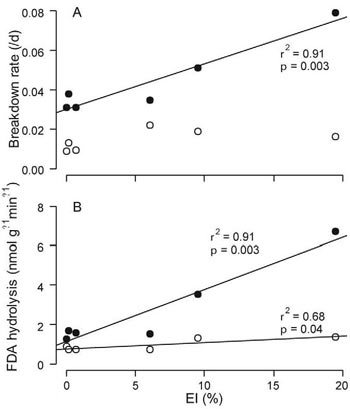
From Imberger SJ et al. 2008. More microbial activity, not abrasive flow or shredder abundance, accelerates breakdown of labile leaf litter in urban streams. Journal of the North American Benthological Society 27(3):549-561. Reprinted with permission.
- Increased leaf decomposition rates related to:
- Increased physical abrasion by high flows
[Paul et al. 2006, Chadwick et al. 2006] - Increased snails
[Chadwick et al. 2006] - Increased microbial activity resulting from ↑ nutrient concentrations and temperatures (Figure 43)
[Chadwick et al. 2006, Imberger et al. 2008]
- Increased physical abrasion by high flows
- Decreased leaf decomposition rates related to:
- Decreased shredders
[Chadwick et al. 2006, Paul et al. 2006, Carroll and Jackson 2008] - Decreased microbial activity
[Paul et al. 2006] - Increased metal contamination
[Woodcock and Huryn 2005, Chadwick et al. 2006]
- Decreased shredders
Primary Production and Respiration
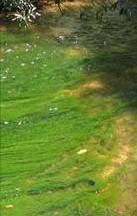
- Increased primary production or algal biomass (Figure 44 and Table 8) resulting from:
- Increased nutrients
- Increased light and temperature
- Decreased grazers
- Decreased primary production or algal biomass resulting from:
- Increased scouring due to high flows
- Increased fine sediment and decreased sediment stability
- Increased toxic pollutants
- Increased grazers
- Altered assemblage structure
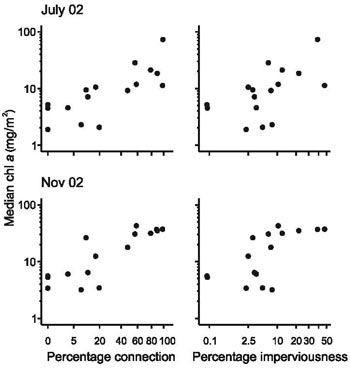
From Taylor SL et al. 2004. Catchment urbanisation and increased benthic algal biomass in streams: linking mechanisms to management. Freshwater Biology 49:835-851. Reprinted with permission.
Many of the factors influencing primary production in urban streams also affect respiration. Respiration does not always show a clear pattern with urbanization, but often is elevated in streams receiving wastewater discharges [Gücker et al. 2006 (Table 8), Wenger et al. 2009]. These increases in respiration can lead to large oxygen fluctuations and oxygen deficits in urban streams [Faulkner et al. 2000, Ometo et al. 2000, Gücker et al. 2006 (see Table 8)].
| Season | Parameter | Upstream | Downstream |
|---|---|---|---|
| Spring | GPP* | 2 | 2 |
| CR24* | 11 | 24 | |
| GPP:CR24 | 0.15 | 0.10 | |
| Summer | GPP | 32 | 47 |
| CR24 | 32 | 59 | |
| GPP:CR24 | 1.0 | 0.8 | |
| Winter | GPP | 0.1 | < 0.1 |
| CR24 | 6 | 18 | |
| GPP:CR24 | 0.01 | < 0.01 | |
| * Both GPP and CR24 measured in g O2 m-2 d-1 Modified from Gücker B et al. 2006. Effects of wastewater treatment plant discharge on ecosystem structure and function of lowland streams. Journal of the North American Benthological Society 25(2):313-329. |
|||
Quantity and Quality of Dissolved Organic Carbon
Dissolved organic carbon (DOC) can play an important role in many streams—for example, by providing a key energy source for stream food webs via bacterial assimilation, or by influencing the bioavailability of metals and other toxics.
Urbanization can affect both the quantity and quality of DOC in streams. Point (e.g., wastewater discharges) and non-point (e.g., impervious surfaces, turf grass) sources can contribute DOC to urban streams. Riparian and channel alteration can alter DOC inputs and processing. In many cases, the quality of these DOC resources will vary.
For example, Harbott and Grace (2005) used bacterial extracellular enzyme activity to examine how urbanization affects DOC bioavailability.
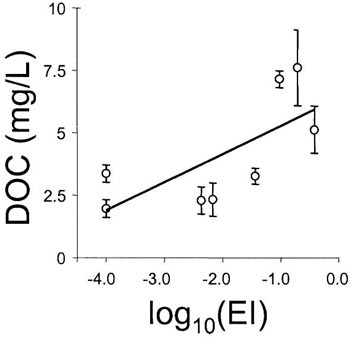
From Harbott EL & Grace MR. 2005. Extracellular enzyme response to bioavailability of dissolved organic C in streams of varying catchment urbanization. Journal of the North American Benthological Society 24(3):588-601. Reprinted with permission.
- DOC concentrations increased with catchment effective imperviousness (EI) (Figure 45).
- The activity of individual enzymes varied with EI, indicating changes in DOC sources (and thus bioavailability) with urban development.
-
In less urbanized streams, DOC sources were more diverse and more dependent on microbial detrital material.
-
In more urbanized streams, DOC sources were more dependent on peptides, perhaps due to processing of filamentous algae.
-
